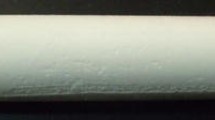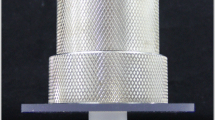Abstract
Nanocomposite aerogels were prepared by chemical vapor deposition and polymerization of cyanoacrylate on the surface of bridged polysilsesquioxane aerogels. Phenylene- and hexylene-bridged aerogels were prepared by sol–gel polymerizations and supercritical carbon dioxide drying. Hydrophobic organic bridging groups in the polysilsesquioxane aerogels reduced the amount of adsorbed water available for initiating polymerizations and led to higher molecular weight polycyanoacrylate than was observed with silica aerogels. Densities increased as much as 65% due to the addition of the organic polymer, but the nanocomposite aerogels remained highly porous with surface areas between 440 and 750 m2/g. Polycyanoacrylate–phenylene-bridged aerogel composites were the strongest with flexural strengths up to 780 kPa or 16-fold stronger than the untreated phenylene-bridged aerogels and fivefold stronger than a silica aerogel of the same density. The strongest polycyanoacrylate–hexylene-bridged aerogel composites had flexural strength of 285 kPa or ninefold stronger than the untreated hexylene-bridged aerogels and twice as strong as a silica aerogel of comparable density. The greater strength of the new composites is, in part, due to the greater strength of the bridged aerogels. However, higher molecular weight polycyanoacrylate, due to less surface water on the hydrophobic bridged aerogels, also contributes to the greater nanocomposite strengths.




Similar content being viewed by others
Notes
Only two data points are shown for the mechanical properties of various density silica aerogels [17] with in the density range in Fig. 2. The plot extends to silica aerogels with densities as high as 0.215 g/cc, but to adequately show the mechanical properties of the bridged composites, the density range was reduced.
References
Pierre AC, Pajonk GM (2002) Chem Rev 102:4243
Fricke J, Lu X, Wang P, Buttner D, Heineman U (1992) Int J Heat Mass Transf 35:2305
Forest L, Gibiat V, Woignier T (1998) J Non Cryst Solid 225:287
Xiao X, Streiter R, Wolf H, Ruan G, Murray G, Gessner T (2001) Microelectron Eng 55:53
Mammeri F, Le Bourhis E, Rozes L, Sanchez CL (2005) J Mater Chem 15:3787
Zhang Z, Shen J, Ni X, Wu G, Zhao B, Yang B, Gu X, Qian M, Wu Y (2006) J Macromol Sci Part A Pure Appl Chem 43:1663
Meador MAB, Vivod SL, McCorkle L, Quade D, Sullivan RM, Ghosn LJ, Clark N, Capadona LA (2008) J Mater Chem 18:1843
Fidalgo A (2007) Chem Mater 19:2603
Harris MT, Knobbe ET (1996) J Mater Sci Lett 15:132
Einarsrud M-A, Nilsen E (1998) J Non Cryst Solids 226:122
Leventis N, Sotiriou-Leventis C, Zhang G, Rawashdeh A-MM (2002) Nano Lett 2:957
Meador MAB, Fabrizio EF, Ilhan F, Dass A, Zhang G, Vassilaras P, Johnston JC, Leventis N (2005) Chem Mater 17:1085
Leventis N (2007) Acc Chem Res 40:874
Zhang G, Dass A, Rawashdeh A-MM, Thomas J, Counsil JA, Sotiriou-Leventis C, Fabrizio EF, Ilhan F, Vassilaras P, Scheiman DA, McCorkle L, Palczer A, Johnston JC, Meador MAB, Leventis N (2004) J Non-Cryst Solids 350:152
Meador MAB, Capadona LA, McCorkle L, Papadopoulos DS, Leventis N (2007) Chem Mater 19:2247
Boday DJ, DeFriend KA, Wilson KV, Coder D, Loy DA (2008) Chem Mater 20:2845
Boday DJ, Stover RJ, Muriithi B, Keller MW, Wertz JT, DeFriend-Obrey KA, Loy DA (2009) ACS Appl Mater Interfaces 1:1364
Loy DA, Shea KJ (1995) Chem Rev 95:1431
Shea KJ, Loy DA, Webster O (1992) J Am Chem Soc 114:6700
Shea KJ, Loy DA (2001) Chem Mater 13:3306
Small JH, Shea KJ, Loy DA (1993) J Non Cryst Solids 160:234
Corriu RJP, Moreau JJE, Thepot P, Wong Chi Man M (1992) Chem Mater 4:1217
Loy DA, Shea KJ, Russick EM (1992) Mater Res Soc Symp Proc 271 (Better Ceramics through Chemistry V), 699
Loy DA, Jamison GM, Baugher BM, Russick EM, Assink RA, Prabakar S, Shea KJ (1995) J Non Cryst Solids 186:44
van Bommel MJ, de Haan AB (1994) J Mater Sci 29:943. doi:10.1007/BF00351414
Nguyen BN, Meador MAB, Tousley ME, Shonkwiler B, McCorkle L, Scheiman DA, Palczer A (2009) ACS Appl Mater Interfaces 1:621
Meador MAB, Weber A, Hindi A, Naumenko M, McCorkle L, Quade D, Vivod SL, Gould GL, White S, Deshpande K (2009) ACS Appl Mater Interfaces 1:894
Sharp KG, Michalczyk MJ (1997) J Sol Gel Sci Technol 8:541
Hobson ST, Shea KJ (1997) Chem Mater 9:616
Lu Y, Fan H, Doke N, Loy DA, Assink RA, LaVan DA, Brinker CJ (2000) J Am Chem Soc 122:5258
Hayashi S, Hayamizu K (1991) Bull Chem Soc Jpn 64:685
Brinker CJ, Scherer GW, Roth EP (1985) J Non Cryst Solids 72:345
Blomberg S, Ostberg S, Harth E, Bosman AW, Horn BV, Hawker CJ (2002) J Polym Sci Part A Polym Chem 40:1309
Loy DA, Carpenter JP, Alam TM, Shaltout R, Dorhout PK, Greaves J, Small JH, Shea KJ (1999) J Am Chem Soc 121:5413
El Rassy H, Buisson P, Bouali B, Perrard A, Pierre AC (2003) Langmuir 19:358
American Society for Testing and Materials, test method C1684
Woignier T, Phalippou J (1988) J Non Cryst Solids 100:404
Takahashi R, Sato S, Sodesawa T, Goto T, Matsutani K, Mikami N (2005) Mater Res Bull 40:1148
Ryan B, McCann G (1996) Macromol Rapid Commun 17:217
Acknowledgements
We thank the Energy Materials Corp. for supporting this study. We also thank the University of Arizona, Marcus Perry and Mike Read from the Chemistry Instrumentation and Electronics Facility, University Spectroscopy and Imaging Facility, Mass Spectroscopy Facility, and Brian Cherry from the Department of Chemistry at Arizona State University for solids NMR work.
Author information
Authors and Affiliations
Corresponding author
Rights and permissions
About this article
Cite this article
Boday, D.J., Stover, R.J., Muriithi, B. et al. Strong, low density, hexylene- and phenylene-bridged polysilsesquioxane aerogel–polycyanoacrylate composites. J Mater Sci 46, 6371–6377 (2011). https://doi.org/10.1007/s10853-011-5584-7
Received:
Accepted:
Published:
Issue Date:
DOI: https://doi.org/10.1007/s10853-011-5584-7




